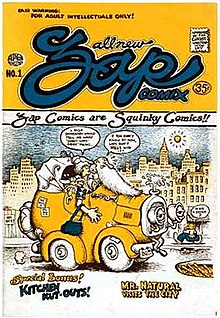| Zap Comix | |
|---|---|
 Cover of Zap Comix #1 (Feb. 1968), art by R. Crumb. | |
| Publication information | |
| Publisher | Apex Novelties (issues #0–3) Print Mint (issues #4–9) Last Gasp (issues #10–15) Fantagraphics (issue #16) |
| Format | Ongoing series |
| Genre | Underground |
| Publication date | February[1] 1968 – November 2014 |
| No. of issues | 17 |
| Main character(s) | Mr. Natural R. Crumb Angelfood McSpade Wonder Wart-Hog Checkered Demon Trashman |
| Creative team | |
| Created by | Robert Crumb |
| Artist(s) | Robert Crumb, Victor Moscoso, S. Clay Wilson, Gilbert Shelton, Spain Rodriguez, Robert Williams, Rick Griffin, Paul Mavrides |
Zap Comix is an underground comix series which was originally part of the counterculture of the late 1960s. While a few small-circulation self-published satirical comic books had been printed prior to this, Zap became the model for the "comix" movement that snowballed after its release. The title itself published 17 issues over a period of 46 years.
Premiering in early 1968 as a showcase for the work of Robert Crumb, Zap was unlike any comic book that had been seen before. While working on Zap #1, Crumb saw a Family Dog poster drawn by Rick Griffin which resembled a psychedelic version of a Sunday funnies page. Its surreal, other-worldly imagery inspired him to think about comics in a new way, as seen in the art style of Zap #1's Abstract Expressionist Ultra Super Modernistic Comics.[2] When Crumb started planning the next issue, he reached out to Griffin, asking him to contribute to Zap #2. Griffin agreed and suggested bringing fellow poster artist Victor Moscoso on board. S. Clay Wilson, Gilbert Shelton, Robert Williams, and "Spain" Rodriguez were also contributors to Zap.[3]
While the origin of the spelling "comix" is a subject of some dispute, it was popularized by its appearance in the title of the first issues of Zap. Design critic Steven Heller claims that the term "comix" ("co-mix") refers to the traditional comic book style of Zap, and its mixture of dirty jokes and storylines.[4]
- ^ Fox, M. Steven. "Zap Comix #1", ComixJoint. Accessed Oct. 21, 2016.
- ^ Robert Crumb (w, a). "Abstract Expressionist Ultra Super Modernistic Comics" Zap Comix, no. 1, p. 11 (February 1968). Apex Novelties.
- ^ Fox, M. Steven. "Zap Comix", ComixJoint. Accessed May 7, 2024.
- ^ Heller, Steven. 1999. Design Literacy: Understanding Graphic Design, New York: Allworth Press.